Uluru Aboriginal Art and Culture offers visitors a unique opportunity to enjoy the rich heritage of the Aṉangu people. Through a range of engaging activities, travelers can explore the profound spiritual connection these Indigenous Australians share with their land. From guided Mala walks to traditional dot painting workshops, the experience highlights the Aṉangu’s intricate understanding of their environment and the significance of oral storytelling in preserving their cultural identity. This immersive journey promises to leave a lasting impression, as visitors discover the vibrant artistry and profound wisdom that have been passed down for generations.
Key Points
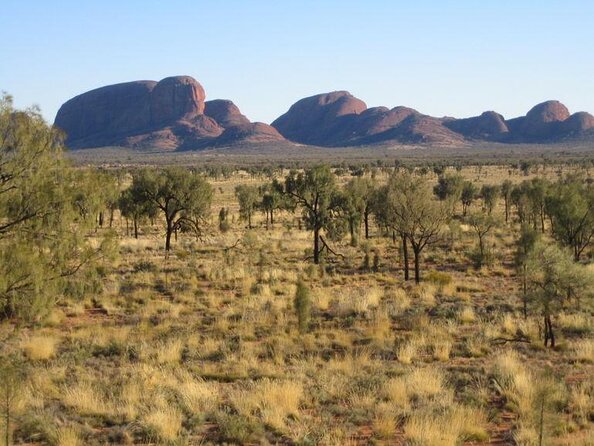
- The tour offers a guided Mala walk, revealing the Anangu people’s spiritual connection to the iconic Uluru landmark.
- Participants can engage in a traditional dot painting workshop, learning techniques that highlight the Anangu’s understanding of the environment.
- Oral storytelling traditions, passed down for generations, impart lessons, historical accounts, and beliefs that connect the physical and spiritual realms.
- Experienced Aboriginal guides share extensive knowledge of the harsh desert environment, including mastery of water sources, edible plants, and animal tracking.
- The tour includes hotel pickup, transportation, and park entry fees, ensuring a seamless and accessible culture experience.
Tour Overview
The half-day tour of Uluru provides travelers with an intimate experience led by local Aṉangu guides, offering insight into the world’s oldest living culture.
With a maximum of 16 travelers, the tour includes a guided Mala walk and a traditional dot painting workshop, allowing participants to enjoy the rich cultural traditions of the Aṉangu people.
Comprehensive commentary from experienced Aboriginal guides and interpreters ensures that guests gain a deeper understanding of the survival skills and oral storytelling traditions that have sustained the Aṉangu for over 60,000 years.
The tour also includes hotel pickup, transportation, and entry fees to the Uluru-Kata-Tjuta National Park, making it a convenient and comprehensive cultural experience.
You can also read our reviews of more tours and experiences in Uluru.
Cultural Insights

Engaging in the guided Mala walk, travelers learn about the deep spiritual connection the Aṉangu people have with Uluru, as their local guide shares the oral storytelling traditions that have been passed down for generations. These ancient narratives illuminate the Anangu’s remarkable survival skills honed over more than 60,000 years in this arid landscape. During the traditional Aboriginal art painting workshop, guests gain hands-on experience creating their own dot paintings, seeing this timeless cultural practice. The art forms and techniques conveyed highlight the Anangu’s profound understanding of their environment and their innovative ways of living in harmony with the land.
| Storytelling Tradition | Survival Skills |
|---|---|
| Passed down for generations | Honed over 60,000 years |
| Illuminate spiritual connection | Innovative ways of living in harmony |
Guided Mala Walk
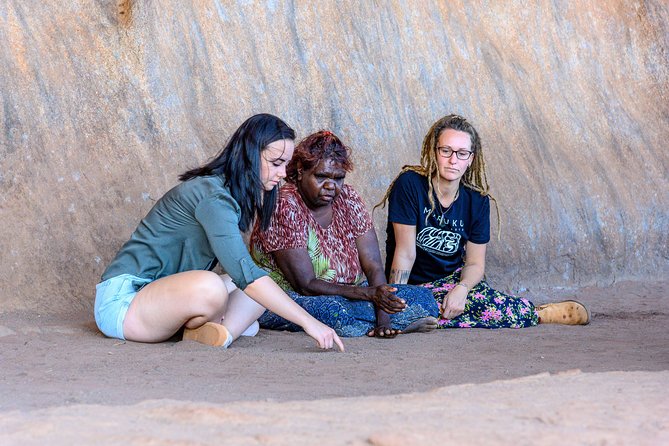
Commencing the guided Mala walk, travelers gain insights into the profound spiritual connection the Aṉangu people share with Uluru, as the local guide recounts the oral storytelling traditions passed down for generations.
The Mala walk explores the Mala people’s historic camp site, providing a deeper understanding of their daily lives and rituals.
The experience includes:
-
Visiting the Kantju Gorge, where the Mala people once sheltered.
-
Observing examples of rock art left by the Mala people over centuries.
-
Learning about the Mala people’s hunting and gathering techniques.
-
Taking in the serene natural environment that holds deep cultural significance.
This intimate journey offers a window into the ancient wisdom and lifeways of the Aṉangu, enriching visitors’ appreciation for the timeless connection between this land and its traditional custodians.
Dot Painting Workshop
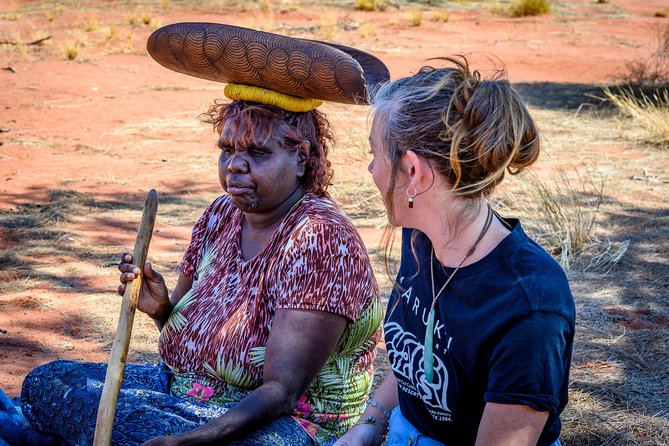
During the dot painting workshop, travelers have the opportunity to learn the traditional art form and techniques of the Anangu people. Under the guidance of a local artist, participants create their own dot painting masterpiece, gaining insight into the cultural significance and symbolism behind this ancient practice. The workshop begins with an introduction to the materials and tools used, such as ochre pigments and wooden dotting tools. Participants then move on to sketching their design and methodically applying the dots to bring their vision to life. The final products showcase the stunning colors, intricate patterns, and rich storytelling that define Anangu dot painting.
| Step | Description |
|---|---|
| 1 | Introduction to materials and tools |
| 2 | Sketching the design |
| 3 | Applying dots with precision |
| 4 | Completing the dot painting masterpiece |
Oral Storytelling Traditions
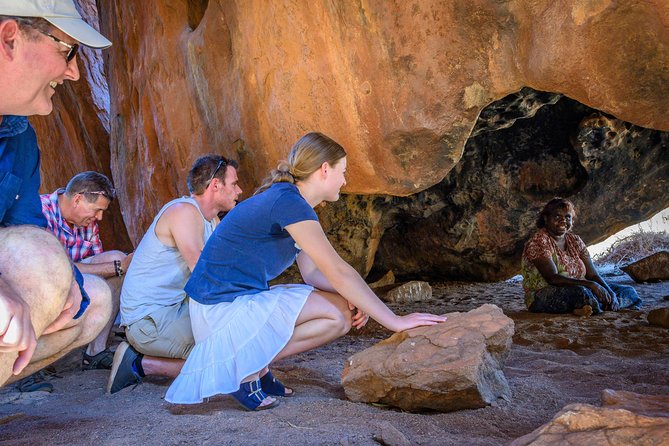
The Aṉangu people have long passed down their rich cultural heritage through an enduring tradition of oral storytelling. This ancient practice serves as a means of preserving their deep connection to the land and their unique worldview.
Through captivating narratives, the Aṉangu elders impart valuable lessons, historical accounts, and spiritual beliefs to younger generations. The oral tradition encompasses:
-
Creation stories that explain the origins of the land, plants, and animals.
-
Survival skills and techniques honed over millennia in the harsh desert environment.
-
Moral codes and social customs that guide community life.
-
Dreamtime tales that connect the physical and spiritual realms.
This living legacy allows the Aṉangu to maintain their vibrant culture and share it with visitors.
Survival Skills
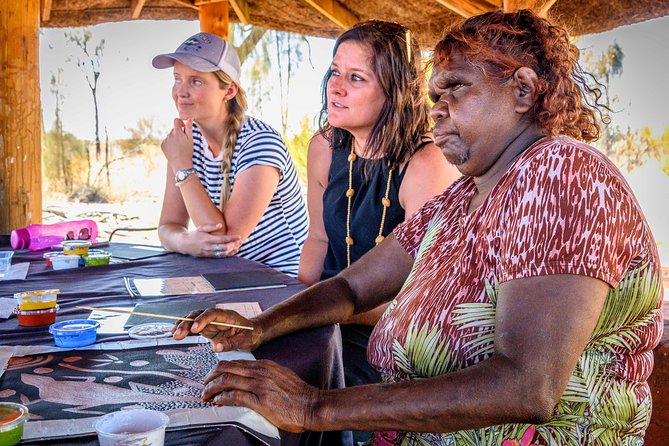
Over millennia, the Aṉangu people have developed a deep understanding of their harsh desert environment, honing an extensive repertoire of survival skills crucial for thriving in this arid landscape.
They expertly navigate the region using intricate knowledge of water sources, edible plants, and animal tracks. Their mastery of fire-making techniques allows them to cook, provide warmth, and ward off predators.
The Aṉangu also possess impressive tracking abilities, using subtle environmental cues to hunt and gather food. Plus, they’ve developed specialized tools and shelters tailored to the desert climate.
These time-tested survival skills have allowed the Aṉangu to thrive in one of the world’s most unforgiving environments for over 60,000 years.
Inclusions and Logistics

This tour package includes several key elements to ensure a seamless experience. Travelers receive hotel pickup and transportation in an air-conditioned coach, with the Uluru-Kata-Tjuta National Park entry fee covered. On top of that, the tour provides comprehensive commentary from an experienced Aboriginal guide and interpreter throughout the journey.
The inclusions of this tour are designed to optimize the cultural learning experience:
-
Reliable transportation to and from the site, allowing guests to focus on the immersive experience.
-
Dedicated, knowledgeable guides who can share insights into the oldest living culture on earth.
-
Seamless entry into the national park, eliminating any logistical hurdles.
-
A comprehensive tour that covers both the practical and cultural aspects of the visit.
Accessibility and Reviews
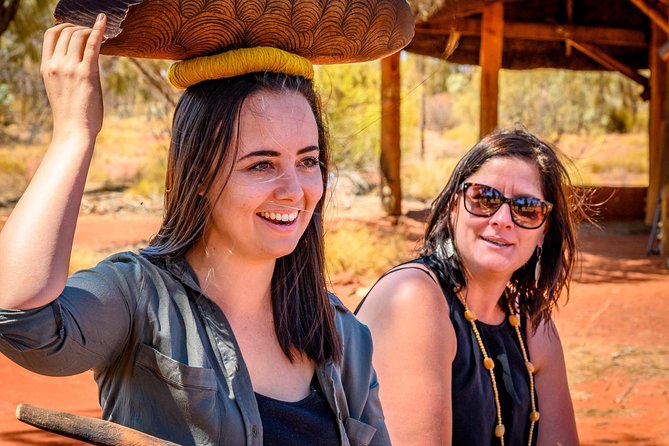
Wheelchair and stroller accessibility is provided for this tour, and infants must sit on laps.
The tour boasts an impressive 5.0 rating based on 4 reviews, and free cancellation is available up to 24 hours before the experience starts. This ensures the tour is accessible to a wide range of travelers, catering to families and those with mobility needs.
The high review score indicates guests have thoroughly enjoyed the culture and educational experience provided by the tour. The flexible cancellation policy further adds convenience, allowing travelers to adjust their plans without penalty.
With these accessibility features and positive feedback, this Uluru Aboriginal art and culture tour appears well-suited for a diverse array of visitors seeking a meaningful cultural encounter.
Frequently Asked Questions
Can I Bring My Own Food and Drinks on the Tour?
Guests are generally allowed to bring their own food and drinks on the tour. However, it’s best to check with the tour operator beforehand, as some tours may have specific policies regarding outside food and beverages.
Are There Any Age Restrictions for the Tour Participants?
The tour has no age restrictions and welcomes participants of all ages. Children can participate in the dot painting workshop, while infants must be seated on laps during transportation.
Is There an Option to Extend the Tour Duration?
The tour does not offer an option to extend the duration. It is a half-day tour with a set itinerary and schedule. Travelers interested in a longer experience would need to book a separate, full-day tour.
Can I Purchase Aboriginal Art During the Tour?
Yes, travelers can purchase Aboriginal art during the tour. The half-day experience includes a traditional dot painting workshop where participants create their own artworks, which they can take home as a souvenir.
Do I Need to Bring Any Special Equipment or Gear?
There’s no need to bring special equipment or gear for the tour. The tour provides all necessary materials, including transportation, park entrance fees, and interpretive commentary from the local Aboriginal guide.
Recap
Uluru Aboriginal Art and Culture offers a profound and immersive experience, allowing visitors to engage with the rich heritage and vibrant traditions of the Aŋangu people.
Through guided walks, workshops, and storytelling, this tour provides a deeper understanding of the Aŋangu’s deep spiritual connection to the land and their ways of preserving cultural identity.
It’s an opportunity to appreciate the harmony between the Aŋangu and their environment.
More Tour Reviews in Uluru
Not for you? Here's more things to do in Uluru we have recnetly reviewed
- 5 Best Dining Experiences In Uluru
- 5 Best Dinner Tours In Uluru
- 4 Best BBQ Experiences In Uluru
- 2 Best Private Car With Driver Services In Uluru
- 9 Best Tours In Uluru
- 4 Best Safari Tours In Uluru
- 2 Best Helicopter Flights And Tours In Uluru
- Uluru(Ayers Rock) to Alice Springs Coach Transfer
- Uluru Sunset BBQ
- Ayers Rock Uluru Private Tour
- Coach Transfer From Ayers Rock (Uluru) to Kings Canyon
- Uluru, Kata Tjuta and Kings Canyon Camping Safari From Ayers Rock
